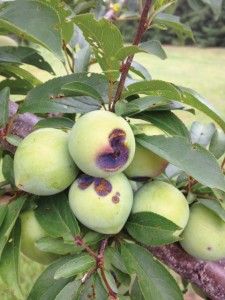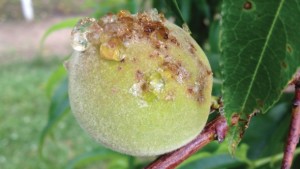How To Keep Your Stone Fruit From Being “Xapped” By Bacterial Spot

Bill Shane
Bacterial diseases can be some of the biggest headaches for fruit growers, and this is particularly true for bacterial spot of stone fruit. This column will focus on prospects for ways to better manage this disease.
Bacterial spot, caused by the pathogen Xanthomonas arboricola pv. pruni — Xap for short — is responsible for leaf and fruit spots on peach, nectarine, apricot, and plum. In years with severe bacterial spot, losses due to fruit spots can easily exceed 20%. Defoliation can be severe enough some years to predispose trees to winter damage. This disease is favored by warm wet conditions and sandy soils. Like most bacterial diseases, blowing sand will make nicks in plant tissue, helping the bacteria to gain entrance.
We have noticed an increase of bacterial spot in recent years on plum and peach in the humid peach growing areas of the U.S. I blame this increase on the planting of newer plum and peach varieties with poorer disease resistance, and on warmer and wetter springs in recent years.
First Signs Of Trouble
The first signals of bacterial spot pathogen activity in a peach orchard are the appearance of tiny black, slightly gummy nondescript “spring cankers” on small branches where the pathogen has overwintered. Next are tiny water-soaked spots on nearby leaves. The spring cankers and tiny leaf spots can be easily overlooked. The first obvious symptoms may show up weeks later when infected leaves develop necrotic spots with conspicuous yellow halos.
Work by Dave Ritchie, professor of plant pathology and Extension specialist at North Carolina State University, and by others has shown that copper sprays are useful in suppressing pathogen movement from spring cankers to leaf tissue. Ritchie has provided guidelines for how to adjust the copper rates to an effective dose while avoiding chemical phytotoxicity. With all the various copper bactericides available, growers have to pay close attention to differences in their metallic copper concentration and formulation in order to use the correct dose in the orchard.

Deep bacterial spot lesions on Japanese plums. (Photo credit: Bill Shane)
Copper’s Popularity In Treatment
Up to a few years ago, copper was used infrequently in peach and plum orchards, in peaches perhaps only as a single spray in the late fall or early spring for peach leaf curl disease management. Currently, five or more copper applications are commonly applied per season for bacterial spot suppression in peach orchards. It is likely that the bacterial spot pathogen in peaches and plums will gradually develop significant resistance to copper.
Widespread bacterial resistance to copper has been seen in California where this compound has been used for many years to control Xanthomonas campestris pv. juglandis, a bacterium very similar to the bacterial spot pathogen that causes walnut blight.
The use of copper and manzate combinations has helped walnut growers deal with copper resistance problems and also may help peach and plum growers. The antibiotic oxytetracycline is also labeled for peaches for bacterial spot, but not for plums, but is effective for only a few days following application.

Bacterial spot (Photo credit: Bill Shane)
Attempts To Recognize Bacterial Spot Conditions
There have been various efforts to understand environmental and plant growth conditions favoring bacterial spot epidemics. Studies of several Xanthomonas species on peach and other crops such as walnut, beans, and small grains have shown that leaf infection is greatly favored by extended periods of rainfall and high humidity that promote water congestion in leaf tissue. There is also evidence that the disease is worse on trees in sandier soils through a subtle physiological effect that favors water-congestion of leaves.
Another piece of the puzzle provided by Ritchie showed in field studies that the critical time for fruit infection is from petal fall though pit hardening. This suggests that bactericide treatment for bacterial spot should be in place before extended episodes of high humidity and rain to help protect leaves from bacteria from spring cankers and from petal fall through pit hardening to protect fruit.
Plum and peach varieties have a wide range of resistances to bacterial spot, and summaries are available from universities and tree fruit nurseries. For very new varieties, there may be scant good information on bacterial spot resistance. A promising new development is the use of genetic tests to identify peach and nectarine genes associated with leaf and fruit resistance to bacterial spot.
Researchers at Washington State University, Clemson University, and the University of Arkansas as part of the USDA-funded RosBREED project have developed genetic probes that can be used to identify peach and nectarine varieties with bacterial spot resistance. Instead of waiting for years of variety trials to determine varietal disease resistance, the answer can potentially be determined in a matter of days by a laboratory with the necessary expertise. Hopefully, with this information plant breeders and nurseries can offer varieties with fewer bacterial spot problems.










